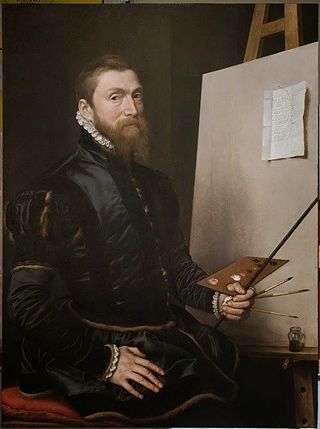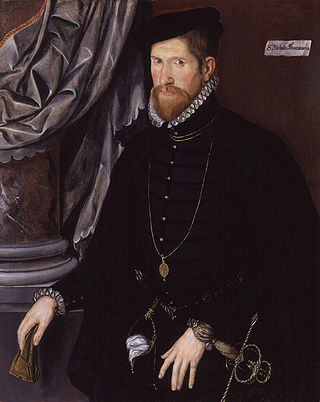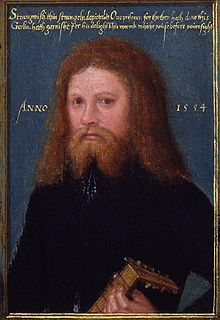
Francis Russell, 2nd Earl of Bedford, KG of Chenies in Buckinghamshire and of Bedford House in Exeter, Devon, was an English nobleman, soldier, and politician. He was a godfather to the Devon-born sailor Sir Francis Drake. He served as Lord Lieutenant of Devon (1584-5).

Anthonis Mor, also known as Anthonis Mor van Dashorst and Antonio Moro, was a Netherlandish portrait painter, much in demand by the courts of Europe. He has also been referred to as Antoon, Anthonius, Anthonis or Mor van Dashorst, and as Antonio Moro, António Mouro, Anthony More, etc., but signed most of his portraits as Anthonis Mor.

Henry Constable was an English poet, known particularly for Diana, one of the first English sonnet sequences. In 1591 he converted to Catholicism, and lived in exile on the continent for some years. He returned to England at the accession of King James, but was soon a prisoner in the Tower and in the Fleet. He died an exile at Liège in 1613.

Sir William Brooke, 10th Baron Cobham, KG, lord of the Manor of Cobham, Kent, was Lord Warden of the Cinque Ports, and a member of parliament for Hythe. Although he was viewed by some as a religious radical during the Somerset Protectorate, he entertained Queen Elizabeth I of England at Cobham Hall in 1559, signalling his acceptance of the moderate regime.

James Hamilton, 3rd Earl of Arran (1537–1609) was a Scottish nobleman and soldier who opposed the French-dominated regency during the Scottish Reformation. He was the eldest son of James Hamilton, Duke of Châtellerault, sometime regent of Scotland. He was of royal descent, and at times was third or fourth in succession to the Scottish crown; several royal marriages were proposed for him, but he eventually never married. He went to France with Mary, Queen of Scots, where he commanded the Scots Guards. After returning to Scotland, he became a leader of the Protestant party against Mary and her French supporters. However, he went insane in 1562 and was confined for the rest of his life.

Sir Nicholas Throckmorton was an English diplomat and politician, who was an ambassador to France and later Scotland, and played a key role in the relationship between Elizabeth I of England and Mary, Queen of Scots.
John Scory was an English Dominican friar who later became a bishop in the Church of England.

The Italian War of 1551–1559 began when Henry II of France declared war against Holy Roman Emperor Charles V with the intent of recapturing parts of Italy and ensuring French, rather than Habsburg, domination of European affairs. The war ended following the signing of the Treaty of Cateau-Cambrésis between the monarchs of Spain, England and France in 1559. Historians have emphasized the importance of gunpowder technology, new styles of fortification to resist cannon fire, and the increased professionalization of the soldiers.

Admiral Sir William Wynter held the office of Surveyor and Rigger of the Navy for 40 years, from 1549 until his death in 1589, and combined that with the office of Master of Navy Ordnance from 1557. He was an admiral and principal officer of the Council of the Marine under Queen Elizabeth I of England and served the crown during the Anglo-Spanish War (1585–1604). He was returned four times to parliament in Elizabeth's time.
Peter Osborne, Esquire, (1521–1592) was an English officer of state who was Keeper of the Privy Purse to King Edward VI, at a time when great constitutional changes affected the management of public finance. Of reformist sympathies in religion, his career was in abeyance during the reign of Queen Mary but regained momentum as Remembrancer in the Exchequer under Elizabeth, working usually to his marital kinsman Lord Burghley. He also sat in seven parliaments between 1559 and 1589.

Oliver St John of Bletsoe, 1st Baron St John of Bletso was an English peer.

Sir John Thynne was the steward to Edward Seymour, 1st Duke of Somerset, and a member of parliament. He was the builder of Longleat House, and his descendants became Marquesses of Bath.
Events from the year 1554 in art.

Sir Edward Rogers was an English gentleman who served as an Officer of State in various capacities during the Tudor period. He rose to become Comptroller and Vice-Chamberlain of the Household to Elizabeth I of England from 1560 to 1568.

Gerlach Flicke, Latin name Gerbarus Fleccius, anglicised in the 16th century as "Garlicke", was a German portrait painter who is known for his work in London as an artist of the Tudor court. Flicke was imprisoned in London and he made a portrait miniature whilst there. This painting is the earliest self-portrait in oils made in England.

Henry Neville, 5th Earl of Westmorland was an English peer, member of the House of Lords and Knight of the Garter.
Sir Thomas Copley (1534–1584) was a prominent English Roman Catholic politician and exile of the reign of Elizabeth I. Knighted, perhaps by the king of France, and created ennobled by Philip II of Spain, he was often known by contemporaries as "Lord Copley".

Sir Giles Strangways, of Melbury Sampford, Dorset, was five times MP for Dorset in 1553, 1554, 1555, 1558 and 1559.

The Treaty of Cateau-Cambrésis or Peace of Cateau-Cambrésis in April 1559 ended the Italian War of 1551–1559, the last of the Italian Wars (1494–1559). It consisted of several separate treaties, the main two signed on 2 April by Elizabeth I of England and Henry II of France, and on 3 April between Henry and Philip II of Spain. Although he was not a signatory, the agreements were approved by Emperor Ferdinand I, since many of the territorial exchanges concerned states that were part of the Holy Roman Empire.

















